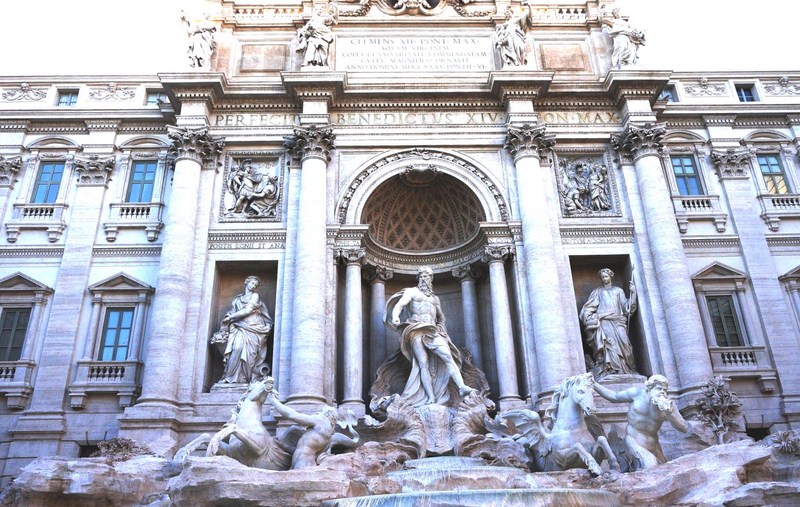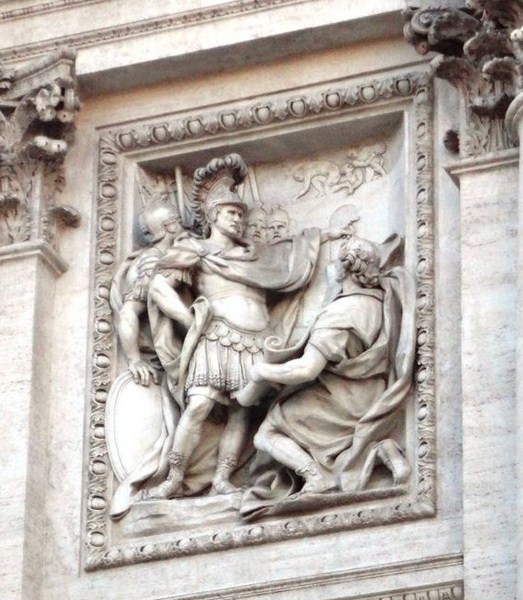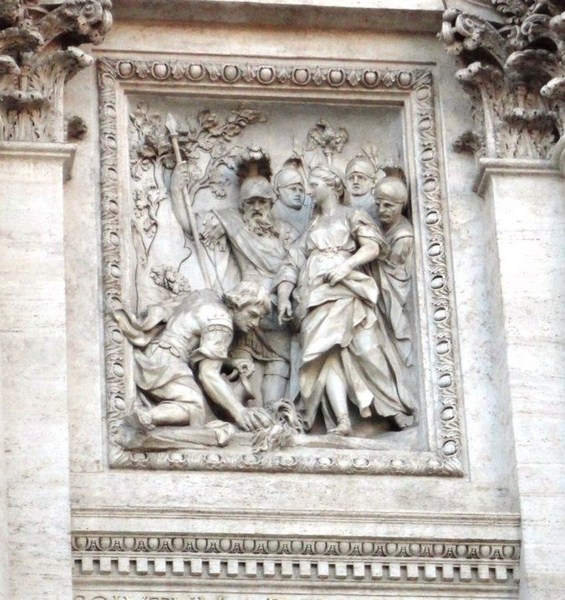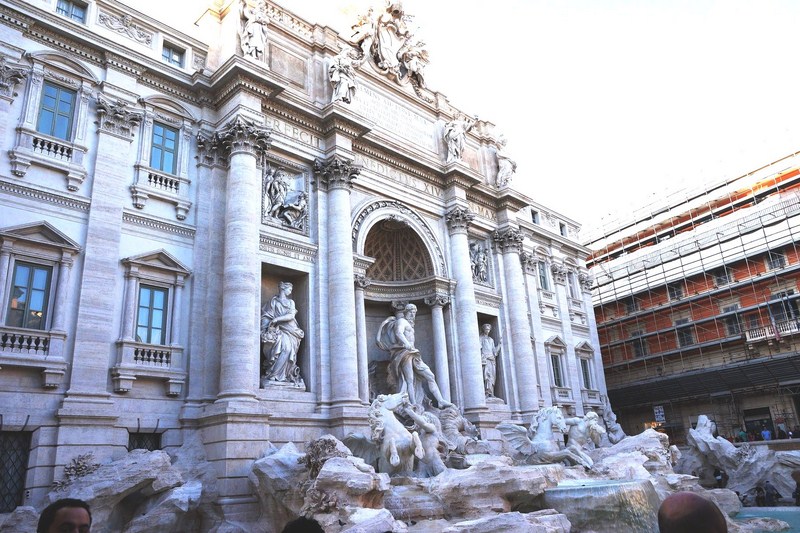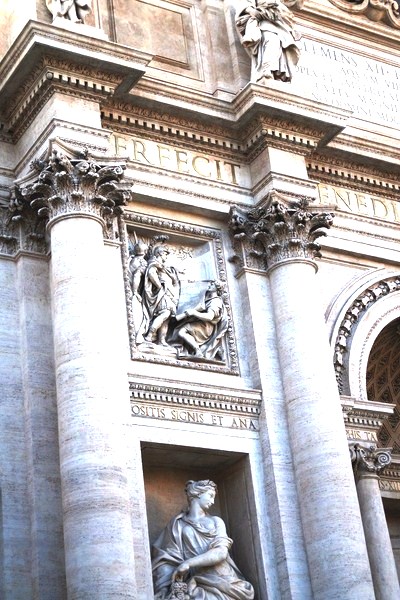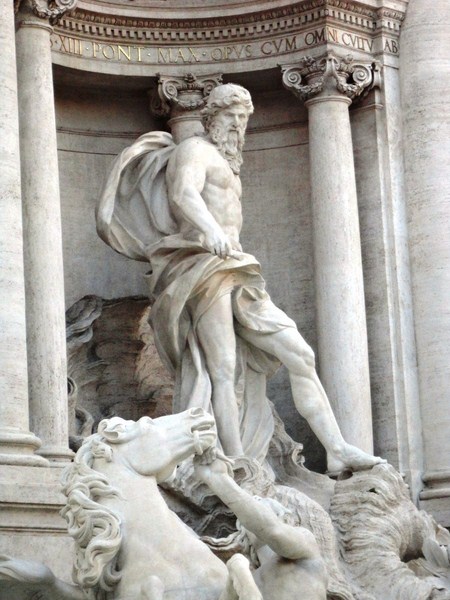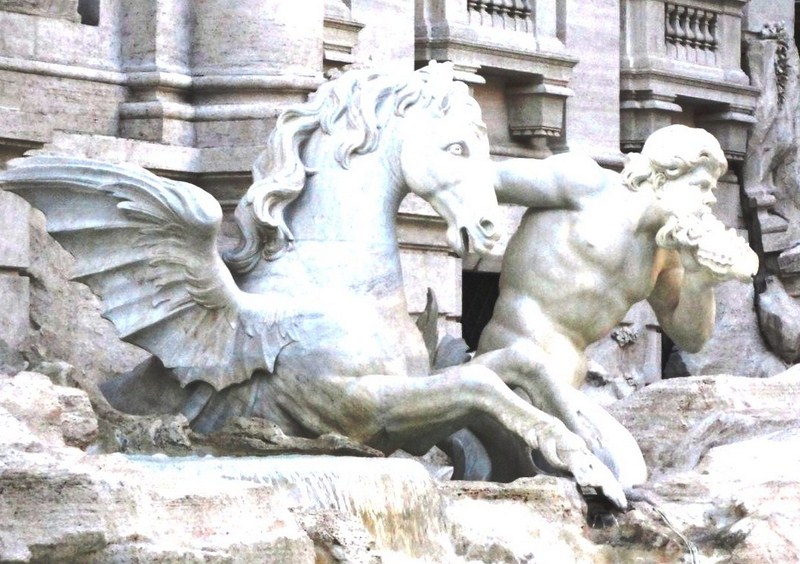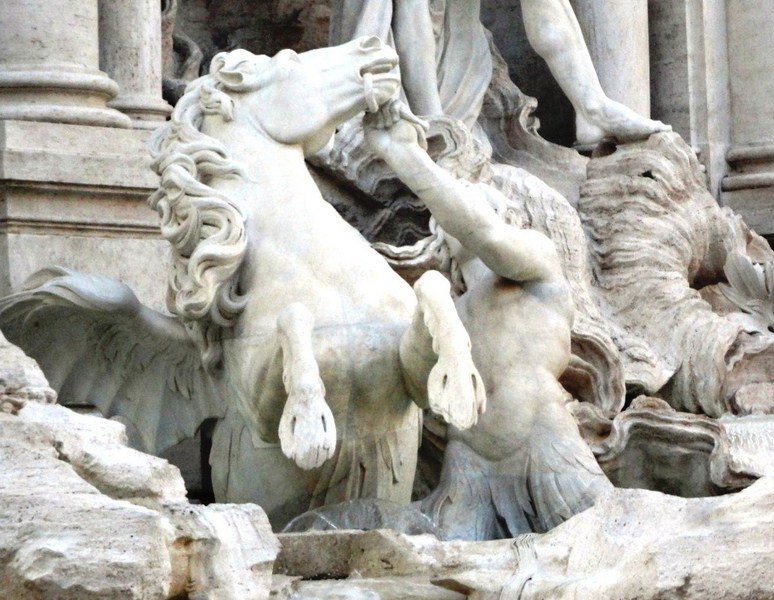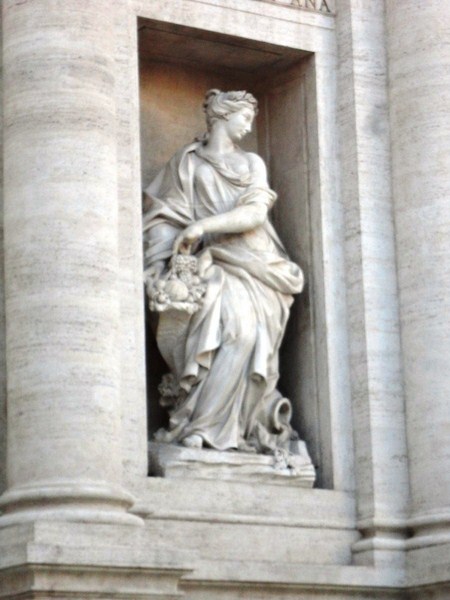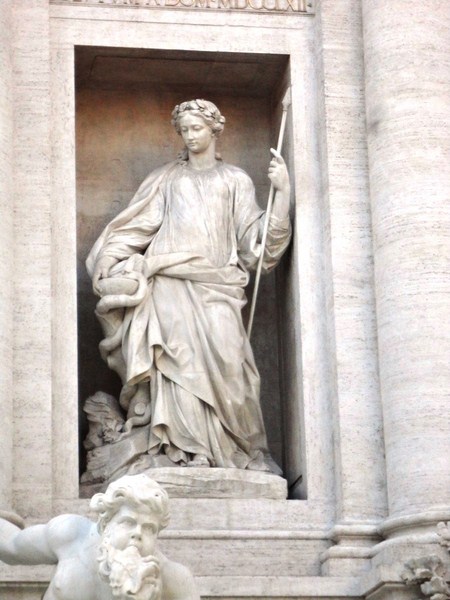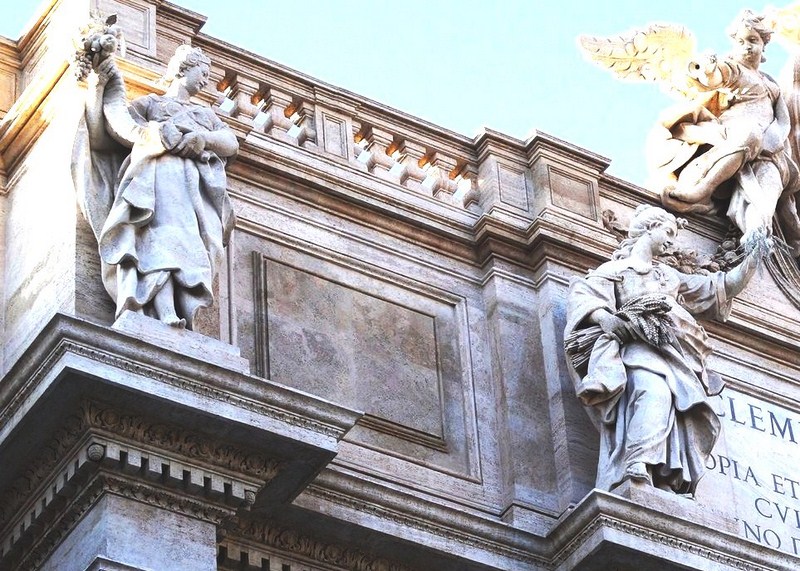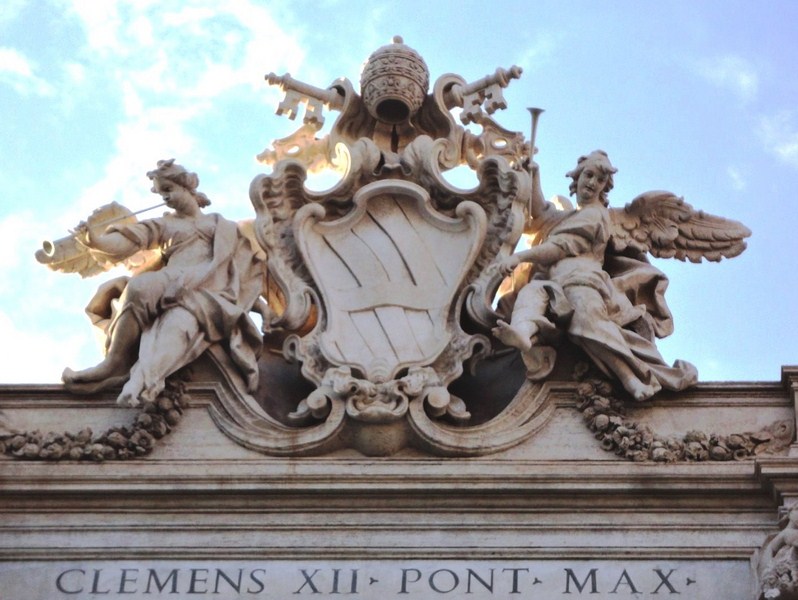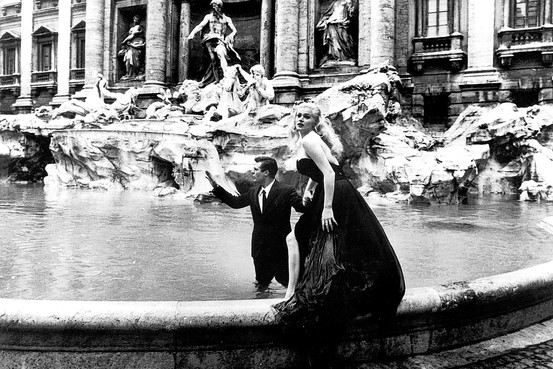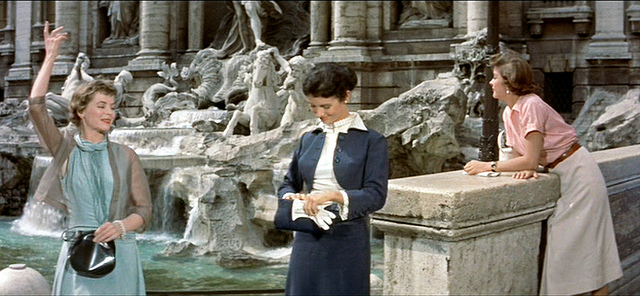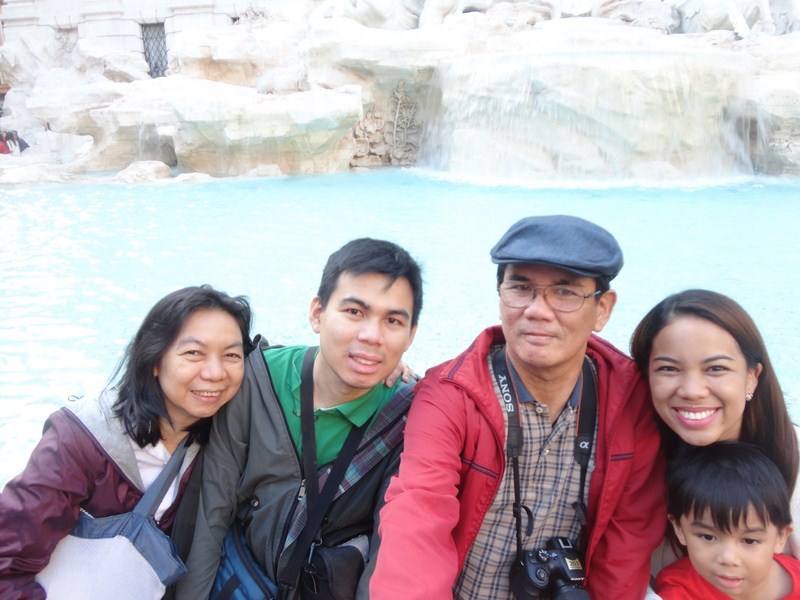The impressive Trevi Fountain (Italian: Fontana di Trevi), designed by Italian architect Nicola Salvi and completed by Pietro Bracci, is one of the most famous fountains in the world and arguably the most beautiful fountain in all of Rome. The fountain, located at the junction of three roads (tre vie), marks the terminal point of the “modern” Acqua Vergine, the revived Aqua Virgo, one of the aqueducts that supplied water to ancient Rome.
Legend has it that in 19 BC, thirsty Roman soldiers, supposedly with the help of a young virgin girl, located Salone Springs, a source of pure water some 13 kms. (8.1 mi.) from the city (This scene is presented on the present fountain’s façade). The discovery of the source led Augustus Caesar to commission the construction, by Agrippa, his son-in-law, of the Aqua Virgo (Virgin Waters, in honor of the legendary young girl), a 22-km. (14-mi.) aqueduct leading into the city. The aqueduct served the hot Baths of Agrippa, and Rome, for over 400 years.
Work on the fountain began in 1732 and it was completed by Giuseppe Pannini in 1762, long after Salvi’s death in 1751, when Pietro Bracci‘s Oceanus (god of all water) was set in the central niche. Pannini substituted the present allegories for planned sculptures of Agrippa and “Trivia,” the Roman virgin. On May 22, 1762, it was officially opened and inaugurated by Pope Clement XIII. Today, it remains one of the most historical cultural landmarks in Rome.
The Palazzo Poli, the backdrop for the fountain, was given a new façade, with a giant order of Corinthian pilasters linking the two main stories. Taming of the waters is the theme of the gigantic scheme that tumbles forward, mixing water and rockwork, and filling the small square. A chariot in the shape of a shell, the central feature of the monument, is drawn by seahorses with as their guide.
Even the palace in the background blends perfectly with the composition and the game of space and mass gives an air of movement to the entire statue.
At the center, superimposed on the palazzo façade, is a robustly-modeled triumphal arch. For maximum light and shade, the enormous central niche (exedra) framing Oceanus (or Neptune), god of the sea, has free-standing columns. He rides a shell-shaped chariot that is pulled by two hippocamps (sea horses), one calm and obedient and the other one restive, and each guided by a Triton.
Sculpted by Pietro Bracci, the statues symbolize the fluctuating moods of the sea. Even with the maximum contrast in their mood and poses, both hippocamps and Tritons provide symmetrical balance.
In the niches flanking Oceanus are the statues of Abundance (spills water from her urn) and Salubrity (holds a cup from which a snake drinks).
Above, bas reliefs illustrate the Roman origin of the aqueducts. The bas-relief on the left shows Agrippa, the general who built the aqueduct that carries water to the fountain, explaining his plan for the aqueduct to his father-in-law Augustus Caesar. The one the right captures the moment the virgin points to the source of the spring. The allegorical statues on the top, in front of the attic, symbolize the Four Seasons. Crowning the top is the coat of arms of Pope Clement XII.
All around, natural and artificial forms merge together in a representation of rocks and petrified vegetation that run along the foundation of the palace and around the borders of a large semicircular basin that represents the sea.
Every day some eighty million liters of water flow over artificial rocks through the fountain. The water is reused to supply several other Roman fountains, including the Fountain of the Four Rivers, the Tortoise Fountain and the Fountain of the Old Boat in front of the Spanish Steps.
Here are some facts and trivia regarding the Trevi Fountain:
- The largestBaroque fountain in the city, the fountain stands 26.3 m. (86 ft.) high, 49.15 m. (161.3 ft.) wide and occupies more than half the square.
- Salvi, before he died in 1751 with his work half finished, made sure a stubborn barber’s unsightly sign would not spoil the ensemble, hiding it behind a sculpted vase, called by Romans theasso di coppe, the “Ace of Cups.”
- The majority of the fountain was made fromTravertine stone, quarried near Tivoli, about 35 kms. (22 mi.) east of Rome.
- In 1973, Italian National Postal Service dedicated a postage stamp to Trevi Fountain.
- In 1998, the fountain was refurbished; the stonework was scrubbed, all cracks and other areas of deterioration were repaired by skilled artisans, and the fountain was equipped with recirculating pumps.
- In January 2013, it was announced that Fendi, the Italian fashion company, would sponsor a 20-month, 2.2-million-euro restoration of the fountain, the most thorough restoration in the fountain’s history. Restoration work, including the installation of more than 100 LED lights to improve the nighttime illumination of the fountain, began in June 2014 and, on the evening of November 3, 2015, the fountain was reopened with an official ceremony.
- There is a curious tradition regarding the Trevi Fountain. It is said that if you throw a coin over your shoulder into the water, you will be sure to return to Rome. Coins are purportedly meant to be thrown using the right hand over the left shoulder (or your left hand over your right shoulder), with your back to the fountain. While you’re tossing the coin, you’re not allowed to look behind you but the fountain is so large it’s basically impossible to miss.
- The fountain has appeared in several notable films, including Federico Fellini‘s renowned 1960 Italian film La Dolce Vita. The scene, on a quiet night in an almost unreal Rome (actually shot over a week in winter), features an alluring Anita Ekberg jumping into the Trevi Fountain, with her clothes on, and invites Marcello Mastroianni to join her. The coin tossing tradition was also the theme of 1954’s Three Coins in the Fountain and the Academy Award-winning song by that name which introduced the picture.
- An estimated 3,000 Euros are thrown into the fountain each day. The money has been used to subsidize a supermarket for Rome’s needy.
- It is illegal to steal coins from the Trevi Fountain. Still, there are regular attempts to steal coins from the fountain.
Trevi Fountain: Piazza di Trevi, Trevi district, 00187 Rome, Italy

